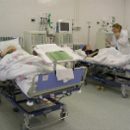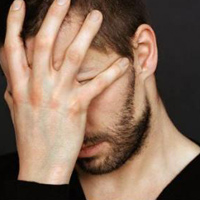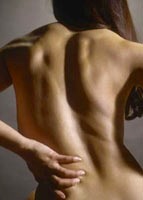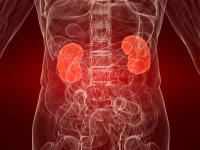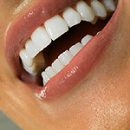Sharp pain, nausea, elevated temperature, blood presence in urine, rapid urination - all these signs of urolithiasis, pictures of the renal colic, forcing the patient to make emergency measures. However, not always pain in urolithic disease are so strong, sometimes they are constant and quite tolerant. About how urolithiasis is manifested, you will learn from the article.
Content
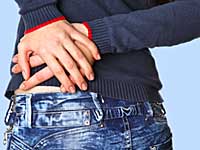 Clinical signs of urolithiasis or urolithiasis are largely dependent on the size, shape of stones, the age of the patient, lifestyle, the nature of nutrition and drinking regime, the presence of concomitant diseases, disorders of urodynamics, duration of the disease and its complications. While the kidney stones have not achieved large sizes and are able to independently stand out with the urine, the only first manifestation of urolithiasis — Sand in urine. Once, passing it for analysis, the patient can detect small concreters at the bottom of the jar, while other symptoms of the disease may not be.
Clinical signs of urolithiasis or urolithiasis are largely dependent on the size, shape of stones, the age of the patient, lifestyle, the nature of nutrition and drinking regime, the presence of concomitant diseases, disorders of urodynamics, duration of the disease and its complications. While the kidney stones have not achieved large sizes and are able to independently stand out with the urine, the only first manifestation of urolithiasis — Sand in urine. Once, passing it for analysis, the patient can detect small concreters at the bottom of the jar, while other symptoms of the disease may not be.
The progression of the illness and the growth of stones makes adjustments to the history of the disease. Urolithiasis, the picture of which was previously hidden from the patient, begins to deliver a lot of concerns, causing attacks of renal colic. The first signs of urolithiasis appear suddenly, causing surprise and cause fright. What is kidney colic and how it manifests itself?
Pain and other symptoms of urolithiasis
Renal colic — This is a whole complex of symptoms, occurring in violation of urine removal from a cup-making kidney system outside. The occurrence of the renal colic is associated with the inclination of the stone at the mouth of the ureter and its promotion down in the direction of the bladder.
The emerging violation of urodynamics causes an increase in the pressure of urine in the kidney, stretching its capsule, the compression of parenchyma causes severe pain, symptoms of intoxication and various reflex reactions.
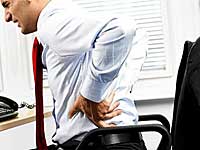 Pains for urolithiasis may wear different severity. In 7-12% of cases, they are not at all bothering the patient or carry a stupid character. Usually such an erased picture in the history of the disease is characteristic of «Coralov». Urolithiasis in the presence of sharp, large stones is manifested by pyelonephritis and permanenting pains, increasing when moving, in a certain position of the body.
Pains for urolithiasis may wear different severity. In 7-12% of cases, they are not at all bothering the patient or carry a stupid character. Usually such an erased picture in the history of the disease is characteristic of «Coralov». Urolithiasis in the presence of sharp, large stones is manifested by pyelonephritis and permanenting pains, increasing when moving, in a certain position of the body.
The occurrence of pain in the urolithiasis in the case of an attack of the renal colic is provoked by a long walking, shaking, abundant fluid intake, however, in the case of the classical columan pain, they have acute character and change little when changing the position of the body.
When the first signs of exacerbation of urolithiasis, pain is localized in the area of the belt, mainly on the one hand. She gives in the stomach, often accompanied by nausea, vomiting, stool delay or diarrhea. Despite the fact that urination is expensive, the amount of urine allocated decreases.
In addition, hematuria and pyuria are often observed with pain at urolithiasis.
With the development of the attack of urolithiasis, first signs are complemented by the body intoxication phenomena. There is a weakness, dryness in the mouth, headache, the body temperature rises, and chills appear, which often mask urolithiasis. Painfully the picture resembles food poisoning, and the irradiation of pain is down, along the rear of the ureter resembles acute appendicitis. Only an experienced doctor and additional research methods can reveal the cause of the disease and decompose the entire history of the disease on the shelves. Urolithiasis does not accept self-medication, since its complications, such as pyelonephritis, hydronephrosis, arterial hypertension, chronic and acute renal failure are not harmless to health.
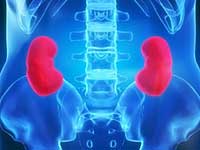 Renal colic stops suddenly, as soon as the stone finishes its path on the ureter and falls into the bladder. If the size of the accurate is greater than 0.5-0.6 mm, it is not able to penetrate the ureter and pain cease, as soon as it changes its position. If the stone remains for a long time in the ureter, due to the complete blockade of the kidney can die, so competent and timely treatment is important when urolithiasis.
Renal colic stops suddenly, as soon as the stone finishes its path on the ureter and falls into the bladder. If the size of the accurate is greater than 0.5-0.6 mm, it is not able to penetrate the ureter and pain cease, as soon as it changes its position. If the stone remains for a long time in the ureter, due to the complete blockade of the kidney can die, so competent and timely treatment is important when urolithiasis.
Complex and confusing history of the disease — Urolithiasis in the elderly. Typical renal colic in age patients occurs 3 times less often than young people, which is due to a decrease in the tone of ureters. In 30% of cases occurs «Cheerful» Urolithiasis, pictures drawn by pyelonephritis, hypertension and renal failure mask the symptoms of stones in the kidneys and often lead to critical situations.


